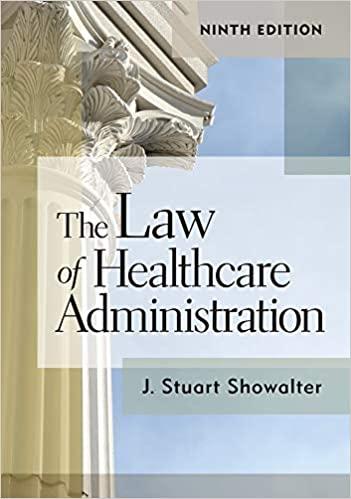Question
Read the post below. Summarize and comment as if you were replying to a classmate. What are your thoughts to the classmates post? CLASSMATE'S POST:
Read the post below. Summarize and comment as if you were replying to a classmate. What are your thoughts to the classmates post?
CLASSMATE'S POST:
In re Complex Asbestos litigation
The conflict in this case surrounded a paralegal, Vogel, who worked for a firm, Brobeck, who represented defendants in litigation surrounding asbestos exposure.Vogel sought employment at another firm, Harrison, who represented plaintiffs in similar type cases in which defendants were represented by Brobeck. Vogel was eventually hired by Brobeck with therequirementto obtain awaiverfrom the senior asbestos litigation partner at Brobeck before Vogelcould start work. In the interim, Vogel worked for Bjork, another firm that handled asbestos litigation cases butwas not required toobtain a waiver from them.When Vogel was eventually hired by Harrison, whodid notverify his waiver from Brobeck, he eventually began working onasbestos litigation cases.He used information he gained while working at Brobeck to work the cases at Harrison and was known to be a talker.The trial courtdisqualifiedthe Harrison firm from 9 of the 20 cases where motions for disqualification were made by Brobeck.The decision was appealed and affirmed by the court.I agree with the outcome, because each step of the way Vogel did not appear to be on the up and up.He was looking for a better opportunity and did not rightfully gain the waivers he shouldhave,and the Harrison firm did not take proper measures to screenVogel from cases where there was potential conflict.
Pheonix Founders
The conflict in this case was from a paralegal, Hargrove, who worked for Thomas & Knight, left to work for David & Goodman for three weeks and returned to Thomas & Knight.These two firms represented two sides of a litigation.Once David & Goodman found Hargrove went back to Thomas & Knight, theynotified Thomas & Knightof the conflict.Hargrove resigned shortlythereafter once given the choice to resign with severance or be terminated.David & Goodman then filed a motion forThomas& Knight to be disqualified under the presumption that Hargrove had shared all confidential information obtained while at David & Goodman.The trial courtdisqualifiedThomas & knight which wasthenappealed.The decision was to send back to the trial court toreconsiderits ruling based on new opinion that was not in place when they originally ruled.The main opinion that was new was that itshouldn'tbe presumed that a paralegal shared all confidential information they hadobtained.The ultimate ruling was not disclosed.
I agree that it should be reviewed again for further evaluation, however, I believe Thomas & Knight should have screened Hargrove more effectively knowing that she had goneto David & Goodman.That would have avoided the potential conflict.Her options to leave the firm werebasically herpunishment for Thomas & Knight failingtoduetheir due diligenceregardingconflicts.
Lamb V.Pralex
In this case, the conflict arises again out of a paralegal,Combie, changing employers that were on opposites of a case and having confidential information that could jeopardize the case.In this instance, however, the hiring firm performedmany steps to avoid potential conflicts in hiringCombieincluding discussing potential conflicts,distributinga list of casesCombieworked on at the prior firm with a memorandum to all employees of the new firm and lockingCombieout of all electronic files.Combiewas also prohibited from discussing anything with the attorney handling the cases whichCombiehad a conflict with.Thecourtdecidedthat disqualification was unwarranted because of the effective screening the hiring firm implemented aroundCombie.I agree with the outcome ofthis, becausethehiringfirm beganidentifyingpotential conflict during the interview processand alsofollowed through upon hiringCombieand actedimmediatelyto notify all staff in the firm.
Zimmerman v. Mahaska Bottling
In this case, the conflict was surrounding a legal secretary, French, who changed sides of a suit and had material and confidential information.The court ruled that the firm, Fisher Patterson, to bedisqualifiedwhich was affirmed on appeal.Thereasoning wasdue to the fact thatFrench has material andconfidentialinformation,and no waiver was obtained with proper screening mechanisms put in place.I amnot sure I agree with this outcome because the court held the KRPC Rule standard of lawyers to a non-lawyer employee as the rule callsfor,but it seems overtly strict for a non-lawyer. It was not discussed whether screening procedures were implemented but if theywere not, they should have been disqualified.
Read the post written by my classmate. Summarize and comment as if you were replying to a classmate. What are your thoughts to the classmates post?
Step by Step Solution
There are 3 Steps involved in it
Step: 1

Get Instant Access to Expert-Tailored Solutions
See step-by-step solutions with expert insights and AI powered tools for academic success
Step: 2

Step: 3

Ace Your Homework with AI
Get the answers you need in no time with our AI-driven, step-by-step assistance
Get Started


